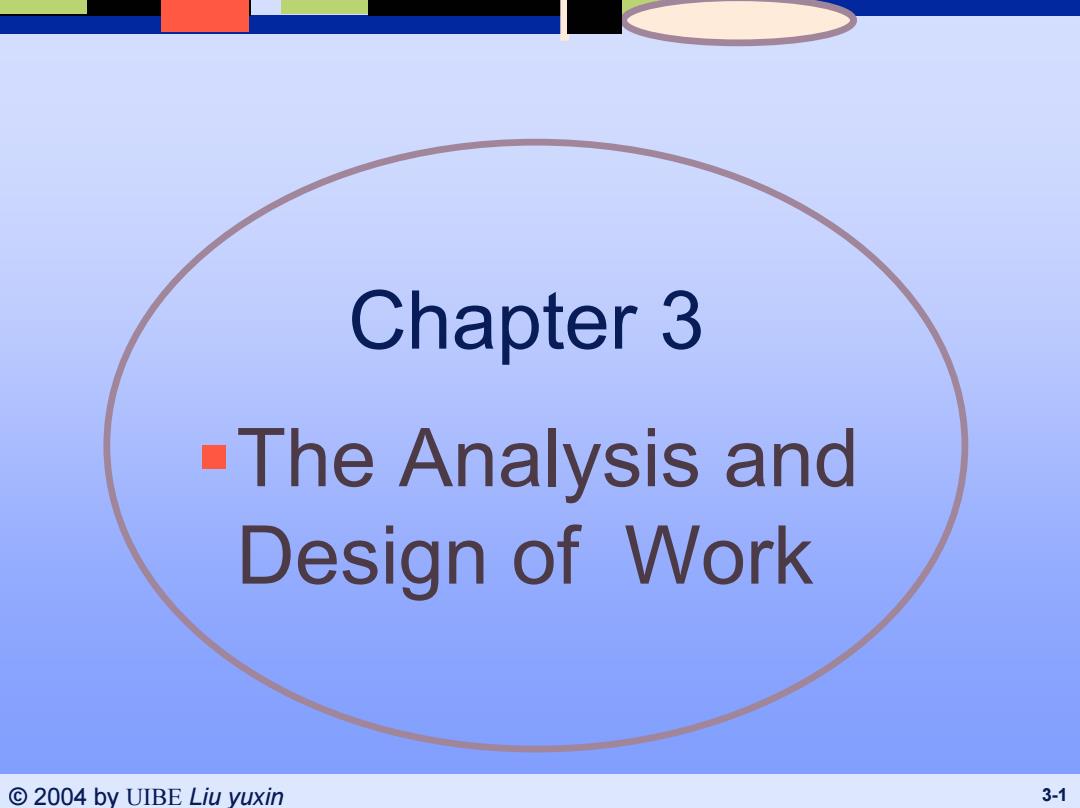
Chapter 3 -The Analysis and Design of Work ©2004 by UIBE Liu yuxin 3-1
© 2004 by UIBE Liu yuxin 3-1 Chapter 3 The Analysis and Design of Work
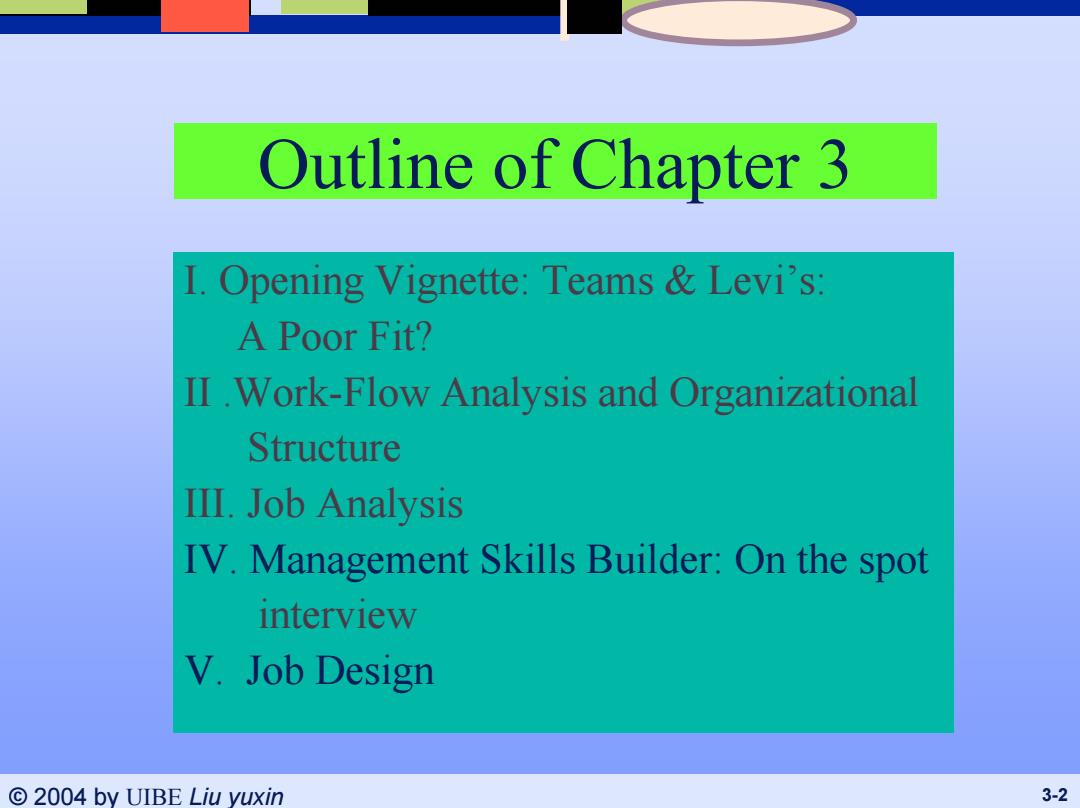
Outline of Chapter 3 I.Opening Vignette:Teams Levi's: A Poor Fit? II.Work-Flow Analysis and Organizational Structure III.Job Analysis IV.Management Skills Builder:On the spot interview V.Job Design ©2004 by UIBE Liu yuxin 3-2
© 2004 by UIBE Liu yuxin 3-2 Outline of Chapter 3 I. Opening Vignette: Teams & Levi’s: A Poor Fit? II .Work-Flow Analysis and Organizational Structure III. Job Analysis IV. Management Skills Builder: On the spot interview V. Job Design
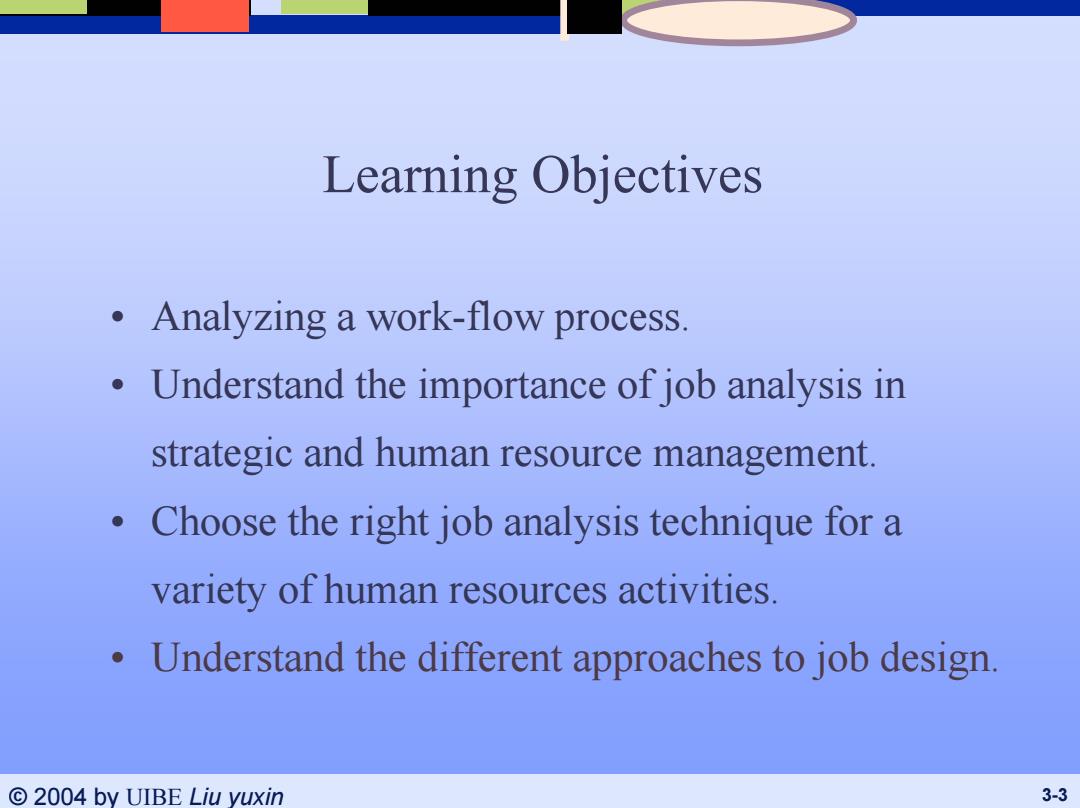
Learning Objectives Analyzing a work-flow process. Understand the importance of job analysis in strategic and human resource management. Choose the right job analysis technique for a variety of human resources activities. Understand the different approaches to job design ©2004 by UIBE Liu yuxin 3-3
© 2004 by UIBE Liu yuxin 3-3 Learning Objectives • Analyzing a work-flow process. • Understand the importance of job analysis in strategic and human resource management. • Choose the right job analysis technique for a variety of human resources activities. • Understand the different approaches to job design
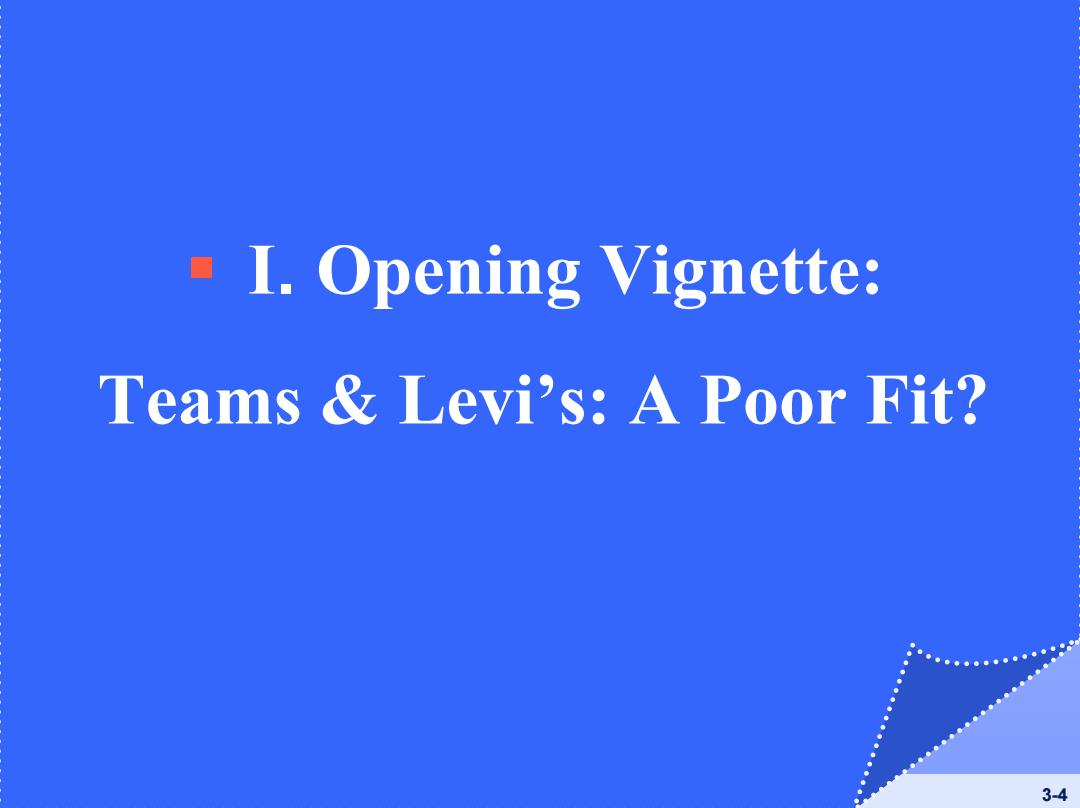
I.Opening Vignette: Teams Levi's:A Poor Fit? 3-4
© 2004 by UIBE Liu yuxin 3-4 I. Opening Vignette: Teams & Levi’s: A Poor Fit?
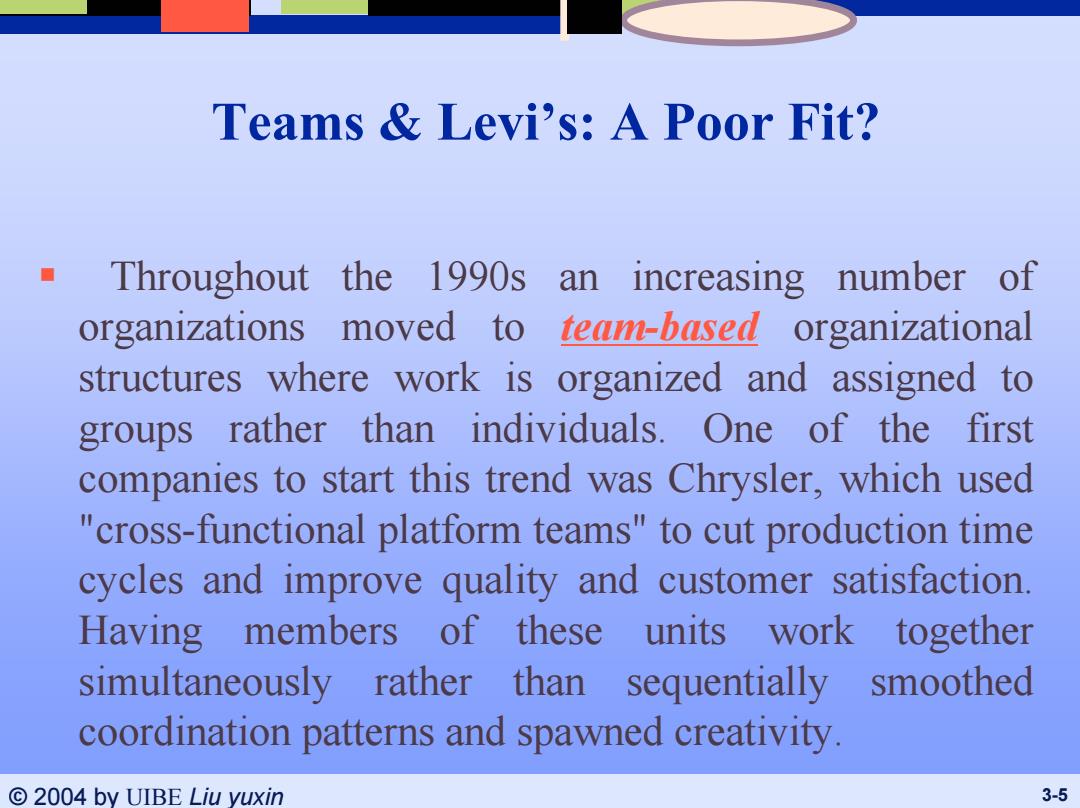
Teams Levi's:A Poor Fit? Throughout the 1990s an increasing number of organizations moved to team-based organizational structures where work is organized and assigned I to groups rather t than individuals.One of the first companies to start this trend was Chrysler,which used "cross-functional platform teams"to cut production time cycles and improve quality and customer satisfaction. Having members of these units swork together simultaneously rather than sequentially smoothed coordination patterns and spawned creativity. ©2004 by UIBE Liu yuxin 3-5
© 2004 by UIBE Liu yuxin 3-5 Teams & Levi’s: A Poor Fit? Throughout the 1990s an increasing number of organizations moved to team-based organizational structures where work is organized and assigned to groups rather than individuals. One of the first companies to start this trend was Chrysler, which used "cross-functional platform teams" to cut production time cycles and improve quality and customer satisfaction. Having members of these units work together simultaneously rather than sequentially smoothed coordination patterns and spawned creativity
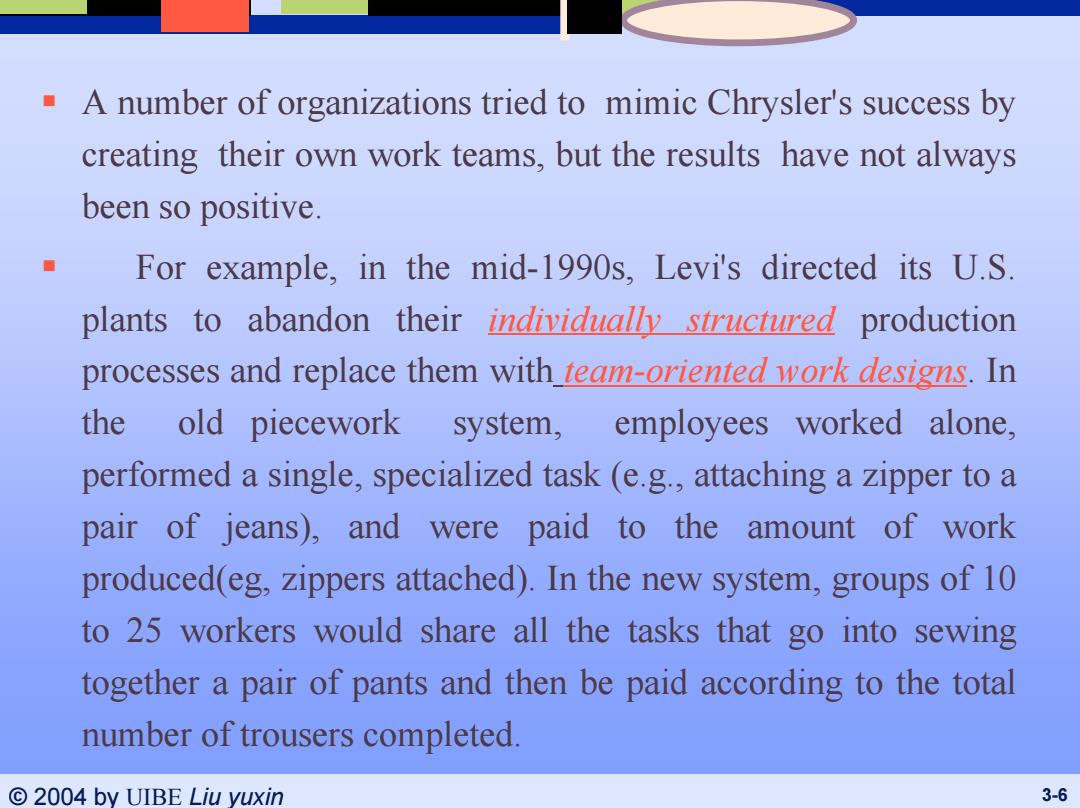
A number of organizations tried to mimic Chrysler's success by creating their own work teams,but the results have not always been so positive. For example,in the mid-1990s,Levi's directed its U.S. plants to abandon their individually structured production processes and replace them with team-oriented work designs.In the old piecework system, employees worked alone, performed a single,specialized task (e.g.,attaching a zipper to a pair of jeans),and were paid to the amount of work produced(eg,zippers attached).In the new system,groups of 10 to 25 workers would share all the tasks that go into sewing together a pair of pants and then be paid according to the total number of trousers completed. ©2004 by UIBE Liu yuxin 3-6
© 2004 by UIBE Liu yuxin 3-6 A number of organizations tried to mimic Chrysler's success by creating their own work teams, but the results have not always been so positive. For example, in the mid-1990s, Levi's directed its U.S. plants to abandon their individually structured production processes and replace them with team-oriented work designs. In the old piecework system, employees worked alone, performed a single, specialized task (e.g., attaching a zipper to a pair of jeans), and were paid to the amount of work produced(eg, zippers attached). In the new system, groups of 10 to 25 workers would share all the tasks that go into sewing together a pair of pants and then be paid according to the total number of trousers completed

By 1998,however,it was clear that these supposed benefits of team-based structures were not going to materialize at Levi's.In fact,if anything,this change in the nature of work had just the opposite effects.Instead of increased worker satisfaction,morale actually went down.The new system led to bitter fights between experienced,skilled workers who were formerly doing well with t the individually based bonus system and slower, inexperienced workers who were holding the team back from its group goals..Efficiency,as measured by the quantity of pants produced per hour worked,dropped to 77 percent of preteam levels,while labor and overhead costs increased by 25 percent. ©2004 by UIBE Liu yuxin 3-7
© 2004 by UIBE Liu yuxin 3-7 By 1998, however, it was clear that these supposed benefits of team-based structures were not going to materialize at Levi's. In fact, if anything, this change in the nature of work had just the opposite effects. Instead of increased worker satisfaction, morale actually went down. The new system led to bitter fights between experienced, skilled workers who were formerly doing well with the individually based bonus system and slower, inexperienced workers who were holding the team back from its group goals.. Efficiency, as measured by the quantity of pants produced per hour worked, dropped to 77 percent of preteam levels, while labor and overhead costs increased by 25 percent
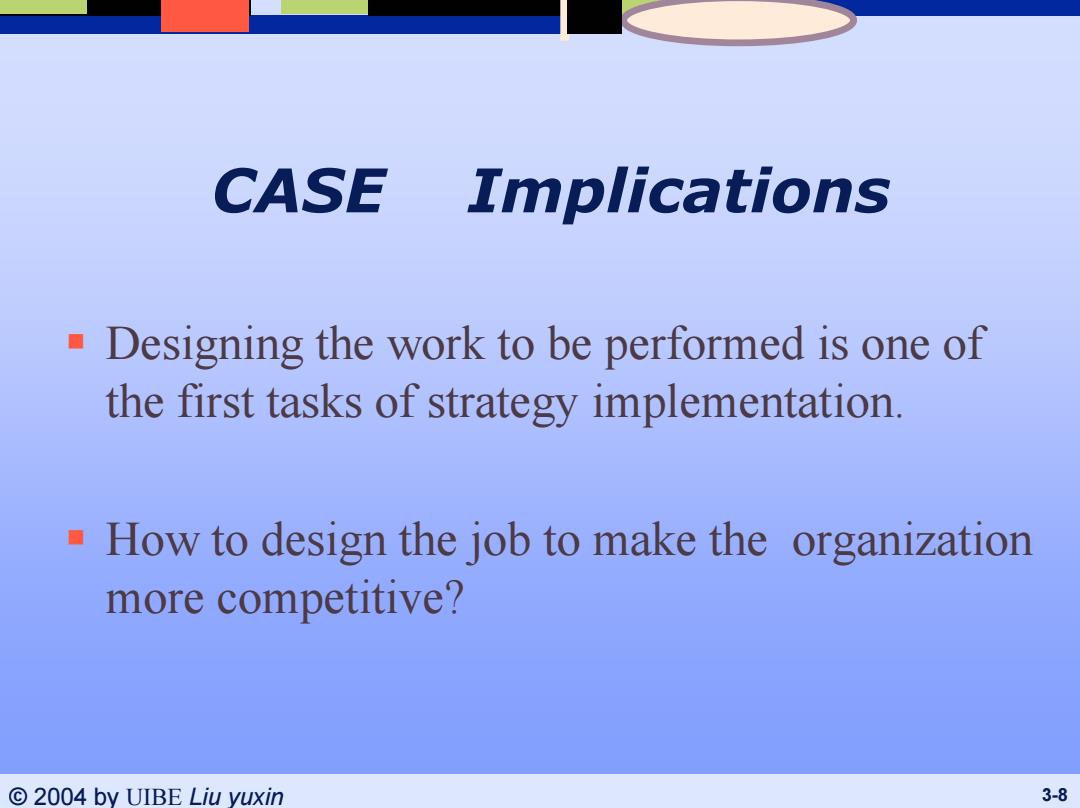
CASE Implications -Designing the work to be performed is one of the first tasks of strategy implementation. How to design the job to make the organization more competitive? ©2004 by UIBE Liu yuxin 3-8
© 2004 by UIBE Liu yuxin 3-8 CASE Implications Designing the work to be performed is one of the first tasks of strategy implementation. How to design the job to make the organization more competitive?

Questions: WHY are Job Analysis and job Design Very important? Without Job Analysis and proper job design,what would happen? ©2004 by UIBE Liu yuxin 3-9
© 2004 by UIBE Liu yuxin 3-9 Questions: WHY are Job Analysis and job Design Very important? Without Job Analysis and proper job design,what would happen?

Problems we have in our daily work improper division of work, Person-based post Blurred Much accidents responsibility Low-efficiency Low morale Org.Goals were not achieved Lack criteria of Responsibility performance overlapping appraisal Important responsibilities missing ©2004 by UIBE Liu yuxin 3-10
© 2004 by UIBE Liu yuxin 3-10 Problems we have in our daily work Blurred responsibility Important responsibilities missing Low-efficiency Low morale Org. Goals were not achieved Lack criteria of performance appraisal Much accidents Responsibility overlapping improper division of work, Person-based post